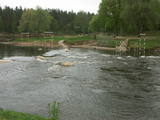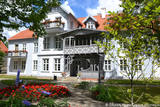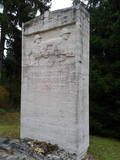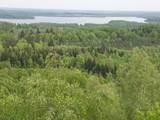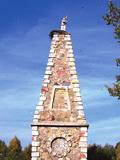| Nr | Nosaukums | Apraksts |
|---|---|---|
|
Latvijas un Baltijas mērogā unikāla teritorija, kas stiepjas no Valmieras līdz pat Gulbenes rajonam un kuras galvenā "ass" ir neregulētās Gaujas ieleja ar blīvu vecupju sistēmu un no bioloģiskās daudzveidības viedokļa vērtīgām pļavām to krastos, ozolu un platlapju audzēm. Daudzu retu un aizsargājamu putnu, īpaši griežu, dzeņu, medņu u.c. sugu dzīves un vairošanās vieta. Viena no nozīmīgākajām lapukoku praulgrauža dzīves vietām. Teritorija ir perspektīva putnu vērošanas, dabas izziņas, ekotūrisma un dažādu veidu aktīvā tūrisma norisēm. Šobrīd teritorijā tiek veidota ar tūrismu saistīta infrastruktūra. |
||
|
Šajā saimniecībā nodarbojas ar kazu audzēšanu un dažādu kazas piena produktu ieguvi, no svaigām izejvielām ražojot kazas sieru un citus produktus. Saimniecības tīrumos audzē arī kartupeļus, sulīgas zemenes un citus produktus. Vasaras nojumē pie galda var sasēsties un omulīgi parunāties 15–20 cilvēku. Tiek piedāvāta viegla maltīte, kas gatavota no 100% saimniecības produktiem. |
||
|
Alus darītava atrodas Ogres novada, Suntažu pagasta Upespilī. IndieJānis alus darītava ir viena cilvēka untums, garadarbs un dzīvesprieks, tāpēc arī saimnieka galvenais mērķis brūvējot ir noteiktas garšas radīšana, nerēķinoties ar produkta pašizmaksu. Alu var iegādāties uz vietas brūzī, iepriekš sazinoties, kā arī krogos - TAKA, Brevings, Zobens un Lemess, Vinilbārs, Alus Muiža, Miezis un kompānija, Valmiermuižas alus vēstniecība. Uz vietas saimnieks rīko alus degustācijas un grupām piedāvā interesantus stāstus par alus brūvēšanu, tradīcijām, pasaules tendencēm, dzeršanas kultūru. Iespējams arī uz dzīvas uguns kopā pagatavot uzkodas pie alus - picas, burgerus, gaļu uz iesma un zupas. |
||
|
Atrodas Rēzeknē, Atbrīvošanas alejā 102. Muzeja ekspozīcija ir izvietota ēkā, kur līdz 2. pasaules karam darbojās Latgales centrālais muzejs. Te iepazīstama Rēzeknes vēsture septiņu gadsimtu garumā, kā arī liela Latgales novadam raksturīgā keramikas un tēlotājmākslas kolekcija. Ekspozīcijā „Māla un uguns pārvērtību radīts brīnums” var iepazīties ar keramikas rašanās un attīstības vēsturi. Savukārt podnieku sētās un darbnīcās var vērot māla izstrādājumu tapšanas (tiek pielietotas senās podniecības tradīcijas) procesu. Pie muzeja uzstādīts piemineklis izcilajam Latgales dzejniekam Antonam Kūkojam (1940 – 2007). |
||
|
Šilutes muižu mūsdienās mēdz saukt tā pēdējā saimnieka vārdā – Hugo Šoja muiža. Šilutes muižnieks, parka izveidotājs Hugo Šojs (Scheu) muižu iegādājās 1889.gadā. Viņš atjaunoja muižas ēkas un apkaimi, tāpat izveidoja 2 parkus: muižas un par “kraukļu mežu” saukto meža parkus. Muižai blakus izveidoja angļu tipa parku ar pastaigu takām. Meža parks, veltīts iedzīvotāju pastaigām, izveidots abās Šišos līkumotās upes pusēs, ko savieno gājēju tilti. Parkā, kas izpleties gar Šišes upi līdz senajam dzelzceļa tiltam, atrodamas ap 150 augu sugas. Šobrīd parkā ir 40 koku sugas un krūmi. |
||
|
Taka ved cauri mežam uz skatu torni purva malā. Takā apskatāma Nāzara priede –priede, pie kuras 1905. gadā nošauts dumpinieks, pati priede – ekoloģiskais koks ar dzilnu kaltiem dobumiem, nokaltusi. Melnalkšņu dumbrājs - slīkšņa ar cūkaušiem un puplakšiem. Oleru purvs no skatu torņa – pārejas un sūnu purvs, kas izveidojies nolaista ezera vietā. Papildus objekti blakus takai, pieejami pa ceļu – Oleru muižas komplekss, Krustakmens, Oleru muižas kapi. Kopējais takas garums: 1,1 km. |
||
|
Atrodas vietā, kur no A 8 autoceļa atdalās ceļš (P 100) uz Ozolniekiem un Jelgavu. Piemineklis veltīts 6. Rīgas kājnieku pulka strēlniekiem, kas krita un pazuda bez vēsts cīņās ar bermontiešiem 1919. gada 17. novembrī pie bijušās Skuju pamatskolas. Pieminekli (autors Nikolajs Voits, bareljefa autors – Mārtiņš Šmalcs, konsultants – Kārlis Zāle) atklāja 1937. g. 24. oktobrī. To atjaunoja 2009. gadā. |
||
|
Tulkojumā no Igauņu valodas Luitemaa nozīmē „Kāpu zeme”. Tā ir Pērnavas līča piekrastes teritorija 13 km garumā starp Vöiste un Häädemeeste ar seklūdeņiem, plašām piejūras pļavām, Igaunijas augstāko kāpu masīvu un Tolkuses purvu (Tolkuse raba). Kāpu un purva apskates nolūkā ir izveidota Tolkuses purva izziņas taka (~ 2,2 km) un skatu tornis. Atrodas Luitemā dabas liegumā. |
||
|
Teritorijas izveides mērķis ir Augšzemes augstienes lielpauguru, ezeru – Sventes (ļoti dzidrs ūdens), Medumu, Ilgas u.c. ezeru, to salu, ainavas un sugu aizsardzība. Teritorijā ietilpst Sventes un Medumu ezeraines dabas parki un vairāki dabas liegumi – Bardinska ezers, Skujines ezers, Medumu ezera salas un Sventes ezera salas. Egļukalnā ir izveidots skatu tornis un kalnu slēpošanas trases. Neparasti skaistais apvidus ir piemērots pārgājienu veikšanai un, ja tajā būtu labākas kvalitātes ceļi, arī velobraucieniem, īpaši Sventes un Medumu ezeru apkārtnē. |
||
|
Piemineklis „Krusta nesējs” celts sakarā ar baznīcas Jubilejas gadu, kas 1825. gadā tika izsludināts Romā un gadu vēlāk visā pasaulē – Svētais Gads. Uz augsta, piramīdai līdzīga, postamenta novietots Kristus tēls, kas nes krustu. Postamentu 1828. gadā uzcēla Livonijas kanoniķis, Rēzeknes dekāns un rakstnieks Jāzeps Kirkillo. 1918. gadā piemineklis atjaunots un uzstādīta statuja ar krustu. Vēlreiz atjaunots 1990. gadā. |
||
|
Suitsu tornis celts 1979. g. kā pirmais Matsalu rezervāta metāla tornis. To atjaunoja 1998. g. Torņa augstums ir 21 m, tādēļ no tā paveras izcila dabas un kultūrainava uz Kazari deltas niedrājiem un blakus esošo Suitsu upi (Suitsu jõgi), kuras krastā ir uzceltas vairākas zvejnieku laivu būdas. |
||
|
Muiža vēsturiskajos dokumentos pirmoreiz ir pieminēta 16. gs. Tagad redzamā vienstāva kungu māja ir vairākreiz pārbūvēta laikā no 17. – 19. gs. 1997. g. ēku vēlreiz atjaunoja un tagad tajā atrodas viesu nams un Vilsandi nacionālā parka apmeklētāju centrs, kur var iegūt ne tikai vērtīgu informāciju, bet arī apskatīt Vilsandi apkārtnē atrastās fosilijas. No Lonas muižas var uzsākt pārgājienu uz Vilsandi salu. Vienā no muižas ēkām ir izveidota Vilsandi nacionālajam parkam veltīta ekspozīcija. |
||
|
Salīdzinoši liela izmēra purvs austrumos no Zaļās kāpas. Tāpat kā Zaļais purvs – nozīmīga sērūdeņu veidošanās un izplūdes vieta. Purvu divās daļās sadala 3,5 km garais Ķemeru – Antiņciema ceļš, no kura paveras interesanta purva ainava. Minētais ceļš nav piemērots braukšanai ar automašīnu! Raganu purva austrumu daļā atrodas grūti pieejamais Putnezers. Savukārt Melnezera krastā, kas atrodas Ķemeru - Jaunķemeru ceļa malā, izveidots neliels auto stāvlaukums un uzstādīts informācijas stends. No šejienes līdz jūras krastam var nokļūt pa vēsturisko un nu jau aizaugošo Veco Ķemeru ceļu. |
||
|
Šis brauciens paredzēts draugu kompānijām vai darba kolektīvam, kas brīvdienas vēlas pavadīt gan aktīvi, gan gan iepazīt Kurzemes kulināro mantojumu un degustēt citus lauku labumus. Brauciena laikā lāpu gaismā un gida pavadībā iepazīsiet Liepājas Karostas Ziemeļi fortus, novērosiet Baltijas jūras piekrastes dažādību un redzēsiet Šlīteres mežus no putna lidojuma augstuma Ovišu bākā. Otrajā dienā iespējams izstaigāt divas dabas takas, kas būs gan aktīvi, gan izglītojoši. |
||
|
Ap 400 gadus vecajos (iespējams, - vecākie Latvijā) muižas pagrabos piedāvā Kurzemes vīndaru mājas vīna šķirņu degustāciju (3 – 7 vīni), kā arī Šlokenbekas muižas īpašo vīnu ar vietējiem lauku labumiem (sola pārsteigumu!). |
||
|
Lielā dziesmu vieta "Dzintari" ir ievērojama ar to, ka tieši tur 1866. gadā norisinājās pirmie latviešu skolēnu koru svētki. Lai iezīmētu šo vietu, 2015. gada vasarā Madonas novada, Praulienas pagasta, Šūpuļkalnā (Madona – Varakļāni ceļa malā) tika uzstādīts Ivara Mailīša veidotais vides objekts “Latvija skan”. Šajā vietā atrodas arī māja, kurā dzīvojis ievērojamais koru virsdiriģents Haralds Mednis (1906-2000). Lai saglabātu mākslinieka piemiņu, 2016. gadā durvis vēra Haralda Medņa 20. gs. 30. gados uzceltā māja “Dzintari”. Tajā apskatāma izstādes par virsdiriģentu Haraldu Medni un Pirmajiem latviešu skolēnu koru svētkiem. Vietai dots skanīgs nosaukums – Lielā dziesmu vieta “Dzintari”. |
||
|
Saimniecības pamatnodarbošanās ir tulpju audzēšana, kolekcijā ir gandrīz 400 dažādu tulpju sīpoli. Pavasarī notiek Tulpju svētki, bet rudenī iegādei pieejami tulpju sīpoli. Neliels dzīvnieku dārzs - ponijs, kaziņas, truši. Kūku, kliņģeru, pīrādziņu un citu gardumu cepšana. |
||
|
Dabiska koka formu apstrādes meistars savās mēbelēs un interjera elementu dizaina izstrādē izmanto koku no saknes līdz galotnei. Katrā darbā tiek akcentēta koka forma, tekstūra un faktūra. Meistardarbnīcā piedāvā neparastu redzējumu par koku un cilvēku. Organizē izglītojošus pasākumus, izgatavo dāvanas un suvenīrus. |
||
|
Vēl viena vieta Kuldīgā, kas pēdējo gadu laikā piedzīvojusi lielas pārvērtības, jo īstenots bijušās pils parka rekonstrukcijas un labiekārtošanas projekts: izveidotas koka laipas, tiltiņi, informācijas stendi, uzcelta lapene un strūklaka. Parkā izvietotas skulptūras un to grupas (22 skulptūras, autore Līvija Razevska), kā arī redzams izteikts uzkalniņš – pils pagraba velve, kurā pēc iepriekšējas pieteikšanās var degustēt vietējā ražojuma vīnus. Šajā vietā 1242. g. vācu ordenis uzbūvēja mūra pili, no kuras līdz mūsdienām ir saglabājušies tikai atsevišķi mūra fragmenti un minētā velve. Vēlākos laikos šeit atradusies Kurzemes hercoga pils, ko sagrāva Ziemeļu kara laikā (1701. g.). Vasarās pilsētas dārzā demonstrē brīvdabas kino. |
||
